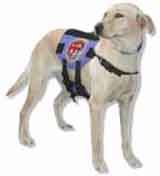Dog Behavior Problems and TrainingChoosing Dog Training Methods |
|
|
Before choosing a particular training method, carefully examine the technique to ensure that it will communicate proper associations. Certain methods may not communicate what you intend. A dog-aggressive Akita was enrolled in a training program that his owner thought was reputable. The trainer convinced the owner that the only way to break the Akita of aggression toward other dogs was to let a more dominant dog put him in his place. The trainer's dog displayed dominance toward other dogs, so she placed him in a room with the Akita and left the two dogs to work things out. When the trainer heard a window crashing, she opened the door to find that her dog was injured, and the Akita had been richly rewarded for his aggressive behavior with a nice victory under his collar. If this method does not make sense to you, it probably won't make sense to the dog, either. One trainer sent around a flyer giving free advice to the general public on how to stop dogs from digging. The trainer suggested filling the newly dug hole with water and taking the dog over to the hole by the scruff of the neck to dunk his head in the water filled-hole. The next sentence on this flyer cautioned the owner that the dunking probably would not stop the dog from digging; instead, forcing the dog down to the water by the scruff of the neck was a demonstration of dominance, a root cure-all for problem behavior. The trainer thought through the method far enough to figure out that the water would have no effect on future digging. Unfortunately, he did not explain that the dog would learn to mistrust his owner for trying to drown him. Shortly after this flyer was distributed, another trainer was indicted for animal abuse for employing this very correction technique. Occasionally, even thinking through a method does not result in a clear understanding of how it works. One day a fellow drove up to class in a pickup with his dog in the back. The dog trainer explained to him that it was very dangerous to have the dog in the back of an open pickup. He went through the normal lecture on how the dog's nose and eyes could be damaged from debris in the air, the danger of the dog being thrown out of the truck in an accident, etc. The fellow proudly said, "I fixed the dog from jumping out of the truck. He was jumping out and I would throw him back in. We did this for five or six times when I finally got really mad and threw him in the truck for the seventh time and stuffed a piece of horse manure in his mouth for good measure. After that the dog never jumped out again, and the next time he does something bad, I am going to use that manure trick again." It was really hard to determine if the dog stopped jumping out of the truck because he got tired of being thrown back in, or if he was grateful for the gourmet horse manure treat. If you are not sure about exactly how or why a method works, it is probably best to avoid the technique altogether. Even the most popular methods use techniques that may not be suited for every breed or temperament of dog. A trainer who evaluates each method based on the efficacy of the associations and motivators will be better equipped to match the appropriate obedience method with the dog's individual temperament.Back to the Dog Behavior Problems and Training page
| |
|
Related News About Dogs ' ); // get rid of newsfeed display by carp CarpConf('poweredby',''); CarpCacheShow('http://dogguidance.com/dogblog/?feed=rss2'); ?>
|
|
|
|
|
|
Copyright © 2006-2007 dogguidance.com |


